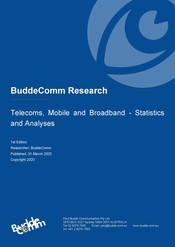2008 Asia - Internet, Broadband and Convergence Statistics (tables only)

Last updated: 16 Sep 2008 Update History
Report Status: Archived
Report Pages: 92
Analyst: Peter Evans
Publication Overview
This report provides 262 tables of mobile communications statistics covering 34 countries in Asia. Data for North Korea has not been included due to its paucity and unreliability.
Researchers:- Peter Evans and Lisa Hulme-Jones
Current publication date:- September 2008 (14th Edition)
Next publication date:- November 2009
Executive Summary
This report provides 262 tables of mobile communications statistics covering 34 countries in Asia. Data for North Korea has not been included due to its paucity and unreliability.
Internet
Asia is the world’s leading regional Internet market in terms of subscribers. With an estimated 435 million Internet users by June 2007 - a population penetration of just over 12% - Asia has been increasing its lead over Europe (320 million) and North America (230 million), as expansion in the latter two regions slows. Internet growth in Asia continues to be dominated by the developed economies of the region - Japan, Hong Kong, South Korea, Singapore and Taiwan. This group has been joined by China, based on its sheer weight of numbers; it was claiming 137 million Internet users by end-2006, a penetration in excess of 10%. In the developing economies of Asia, Internet use was still only moving forward at a steady pace due to a range of constraints which included the high cost of access, poor telecommunications infrastructure and the slow rate of deregulation. Nevertheless, even in the developing economies of the region, the promise of the economic returns generated by the Internet has been pushing both governments and the private sector towards modernisation.
After the developed Asian economies led an initial high growth period, Asia has continued to advance, but at a somewhat slower pace, with an annual growth rate in Internet users of close to 20% coming into 2007. Of critical importance, the emphasis has shifted to increasing speed and sophistication of the access provision. The region has moved rapidly ahead in the application of high-speed broadband Internet access, increasingly the preferred mode worldwide. South Korea has been leading the world in its commercial application of broadband technologies.
Broadband
Broadband Internet and its various forms of access have continued to take Asia by storm. But, while broadband is one of the fastest growing market segments in Asia, it has so far only managed to make a major impact in Asia’s developed economies. Everywhere else in the region, the Internet continues to be predominantly accessed using dial-up narrowband access. In terms of broadband household penetration, there is a huge gap between the region’s top six markets and the rest of Asia.
In some of the developing markets, incumbent telcos have been resisting the regional push towards broadband. However, as deregulation takes effect, the emergence of new competitors and a strong demand for high-speed Internet services have been forcing incumbents to ramp-up their broadband access roll-outs despite concerns over the threat to traditional service revenue streams and their investment in legacy networks.
The region has two dominant broadband access modes - DSL and cable modem, with DSL being the major means of access. Asia is the one region of the world where FttH has started to emerge as a serious broadband platform. The technology has taken off in a big way in Japan, with over eight million FttH subscribers by early 2007. Not unexpectedly, the movement towards fibre has been occurring in Asia’s more developed markets, where positive government intervention has been playing an important role. However, the adoption rates have varied considerably from market to market. Invariably, FttH has found itself competing with the copper loop as technology continues to extend the capability of this traditional technology.
Peter Evans
Data in this report is the latest available at the time of preparation and may not be for the current year.
Related Reports
- 2019 Asia - Mobile Network Operators and MVNOs
- 2019 Asia - Fixed Broadband Market - Statistics and Analyses
- 2019 Asia - Mobile Infrastructure and Mobile Broadband
- Cambodia - Telecoms, Mobile and Broadband - Statistics and Analyses
- Philippines - Telecoms, Mobile and Broadband - Statistics and Analyses
- Laos - Telecoms, Mobile and Broadband - Statistics and Analyses
- Singapore - Telecoms, Mobile and Broadband - Statistics and Analyses
- Armenia - Telecoms, Mobile and Broadband - Statistics and Analyses
- Timor Leste (East Timor) - Telecoms, Mobile and Broadband - Statistics and Analyses
- Uzbekistan - Telecoms, Mobile and Broadband - Statistics and Analyses
Share this Report
TMT Intelligence
A platform to scale your intelligence tasks
Monitor critical insights with our AI-powered Market Intelligence Platform gathering and analyzing intelligence in real time. With AI trained to spot emerging trends and detect new strategic opportunities, our clients use TMT Intelligence to accelerate their growth.
If you want to know more about it, please see:
Research Methodology
BuddeComm's strategic business reports contain a combination of both primary and secondary research statistics, analyses written by our senior analysts supported by a network of experts, industry contacts and researchers from around the world as well as our own scenario forecasts.
For more details, please see:
More than 4,000 customers from 140 countries utilise BuddeComm Research
Are you interested in BuddeComm's Custom Research Service?
Hot Topics
News & Views
Have the latest telecommunications industry news delivered to your inbox by subscribing to BuddeComm's weekly newsletter.